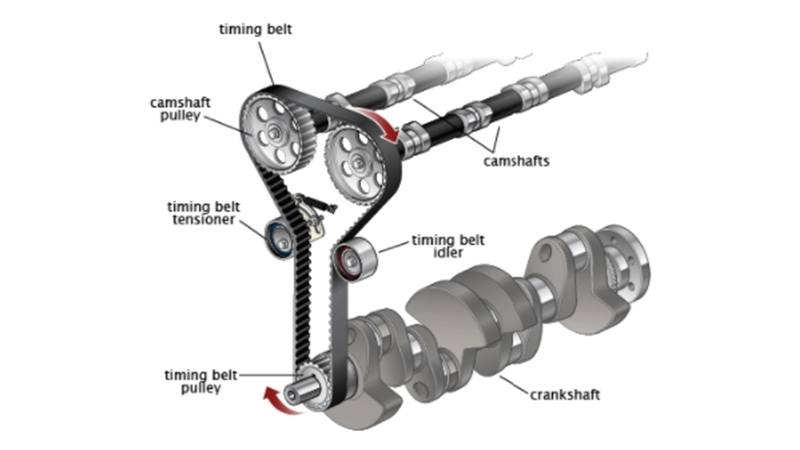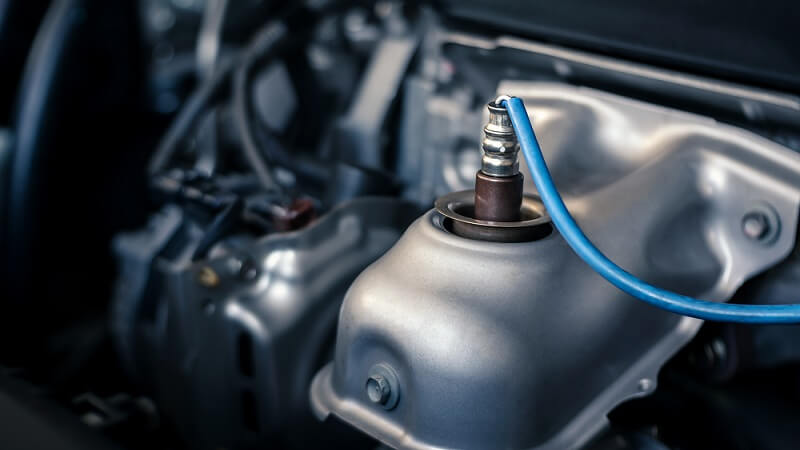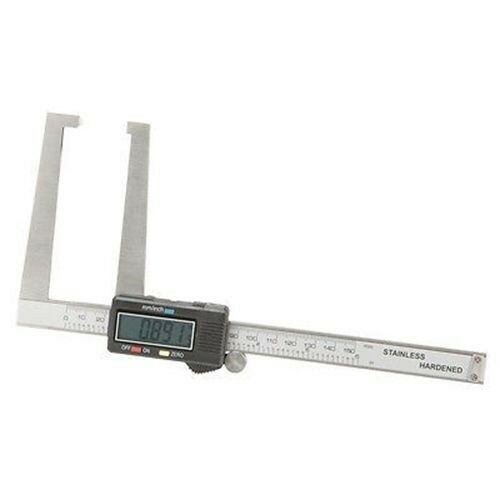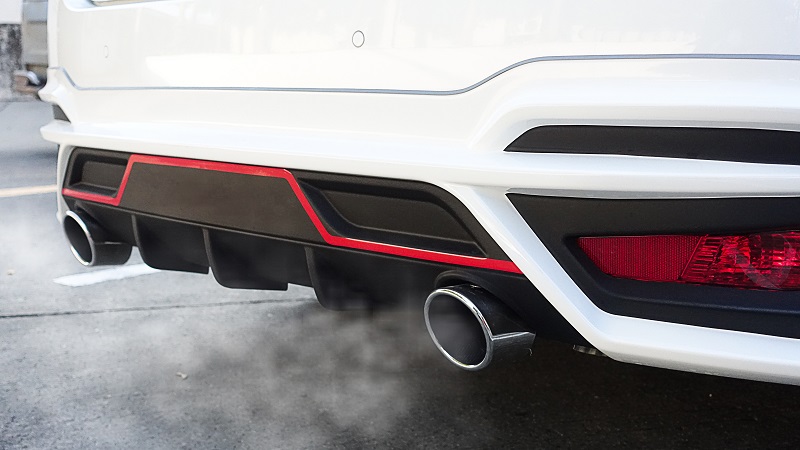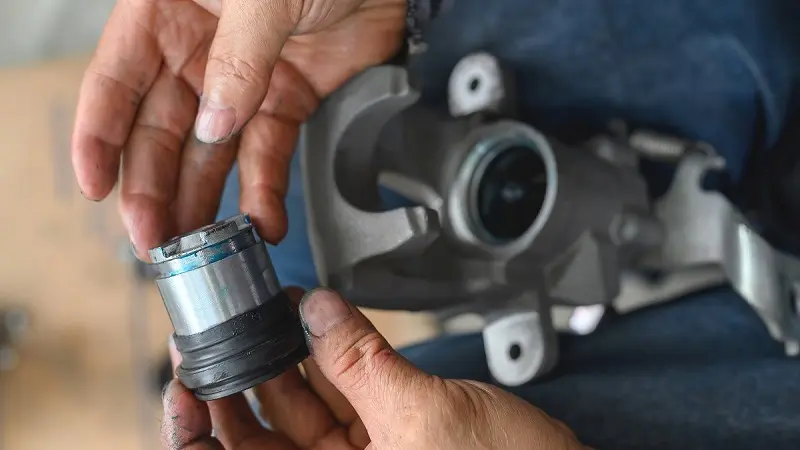While we’re definitely not recommending you do this, there are maintenance procedures you can miss and not do any real damage to your car. Replacing the timing belt isn’t one of them. What makes a failing timing belt incredibly high-risk is the fact that it won’t just leave you stranded at the side of the road, but often do a whole lot of damage as well. To put it simply, a broken timing belt in interference engines often means pistons shaking hands with valves. Needless to say, that’s no bueno.
Fortunately, it’s not difficult to prevent timing belt failure. All you need to do is stay on top of your maintenance and understand the signs of a failing belt.

Article updated on 11/30/21. Original publishing date 03/12/21
What is a Timing Belt
A timing belt is essentially a strong toothed rubber belt that’s positioned at the front of a longitudinally-mounted engine and on the side of a transversely mounted one.
Regardless of its position, the belt sits on a set of pulleys that are located on the outside of an engine, but it’s almost always under a timing belt cover. The main purpose of the timing belt is to drive the camshaft(s) by linking them to the crankshaft. A timing belt ensures that the valves open and close at the proper time for efficient combustion.
While the crankshaft and camshafts serve different purposes, they are required to work in harmony to keep an internal combustion engine running. And it’s a healthy timing belt that makes sure everything is working as it should.
How Often Should You Change Your Timing Belt?
A failing timing belt is a recipe for disaster as we’ve already mentioned. If there’s one piece of information you need to be able to recite in the middle of the night, it’s when to change your timing belt. When you consider just how pivotal its role is, the cost for a replacement seems relatively inexpensive. What one has to keep in mind is that a failing timing belt is inevitable, as it is a wear item and goes through quite a bit of stress.
While a timing belt can fail without warning, that’s a rare occurrence, especially if you replace it on time. The best place to find out the recommended interval for your car is in your owner’s manual. However, if you’ve misplaced it, you should be able to find the information online.
Just make sure you get the engine code right, as the recommended replacement interval will vary depending on the engine. For reference, most manufacturers usually recommend that you have your car’s timing belt replaced every 60,000 to 100,000 miles. Given the fact that a timing belt is mostly made out of rubber, it’ll also age just by sitting for years on end. It is recommended to replace a timing belt at least every 4 years, regardless of the miles on the odometer. Check out our selection of timing belt kits and find a quality replacement for your car!
Symptoms Of a Failing Timing Belt?
Most times, if you are facing a symptom of a failing timing belt, it’s already too late. However, being quick to react may just save your engine. The following symptoms can serve as a good indicator that your timing belt is close to failing, but they are far from a guaranteed tell.
The only real way to know whether your timing belt is about to go is to get up close and personal with it. That being said, you shouldn’t ignore any of the following symptoms.
Ticking Sounds Coming From the Engine
As we mentioned before, a timing belt is attached to a series of pulleys that are connected to the cams and crankshaft among others. Its purpose is to regulate those complex systems and if your timing belt wears out, it can cause a ticking sound from inside the engine.
If you are facing this issue, you should turn your engine off immediately and let your mechanic have a look at it. A ticking noise could also be caused by a bad tensioner pulley, which is not as serious as the aforementioned issue, but it still needs looking at.
All these components are, in a way, interconnected. The tensioner is what keeps the timing belt tight, and the engine oil often pressurizes that tensioner. If the tensioner isn’t getting enough oil pressure, the belt will slack and possibly disengage from the pulleys or break.
Check Engine Light
In some instances, a failing timing belt will trigger your check engine light. The system might pick up on an issue and indicate a code in correlation with the camshaft or crankshaft. That’s why you have to take the check engine light seriously no matter what.
Misfires or Rough Idle
A failing timing belt that’s a bit too worn will negatively affect your engine’s timing. As a result, it could cause a misfire. Rough idle is also a known byproduct of a failing timing belt. Another reason for a misfire could be your engine running lean. Again, these symptoms can mean plenty of things, but shouldn’t be ignored.
Engine Not Turning Over
As you may already know, there are multiple reasons for an engine to not start. One of the reasons could be a broken timing belt. While that’s more trouble to fix than a drained battery, it’s one of the favored symptoms to have when it comes to timing belt failure. A broken timing belt at standstill does a lot less damage than it would if the car was moving.
Squealing Sounds
Another symptom that’s quite common when it comes to failing belts, in general, is a squealing sound. There’s a higher chance that this could be a result of a failing water pump pulley or a serpentine belt, but it doesn’t rule out the possibility of it being a failing timing belt.
What Happens When a Timing Belt Goes Bad?

The consequences of a bad or failed timing belt depend on whether the car has an interference or non-interference engine. With every two crankshaft rotations, the pistons move up and down twice, while the camshaft usually goes through one rotation in which it opens and closes the intake and exhaust valve for optimum combustion.
In interference engines, the pistons share a space in the cylinder with the valves. This means the only thing that’s stopping them from colliding with each other is harmonized timing. So, if the failing timing belt goes bad on this type of engine while it’s running, the valves will stop moving quicker than the crankshaft or the pistons. As a result, they will collide and cause major engine damage.
On the other hand, a non-interference engine is designed in a way in which a broken timing belt won’t do any additional damage. This type of engine won’t face any of the major damage we spoke about earlier, but a broken timing belt will bring it to a stop and potentially leave you stranded.
That said, Interference engines are more common because the valve operation is more efficient and the engine is also capable of a higher compression ratio. They are said to be easier to make power with, while also being less polluting when compared to non-interference engines.
Can You Drive With a Failing Timing Belt?
As you may have realized by now, the timing belt plays a fundamental role in the workings of your car. Driving with a failing timing belt is not recommended at all. If you are aware of the fact that you have a failing timing belt, waste no time in killing the ignition as failing to do so could potentially cost you your engine.
How to Choose the Right Timing Belt for Your Car?
Simply replacing the timing belt on time isn’t necessarily a guarantee that you won’t deal with a failing timing belt in the future. While timely maintenance is key, you also need to carefully choose the quality of parts you install in your car. We offer a wide range of quality Genuine, OEM, and aftermarket timing belts for a wide range of vehicles.
To find the one that fits your particular car, simply head over to our store and select your vehicle from our drop-down menu. Our system will return a list of products that are a guaranteed fit!


